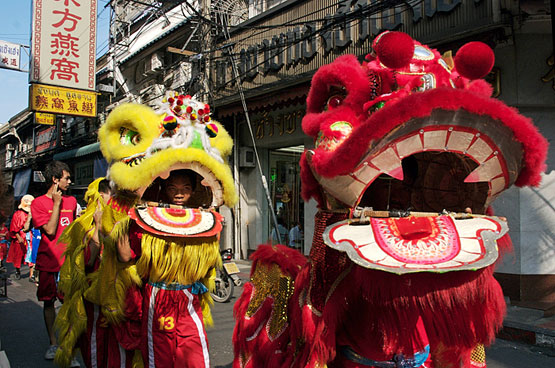恭喜發財 gùng héi faat chōi!
Today's the first day of the Lunar New Year!
I love close to Stanford, so I was fortunate to be able to go home and celebrate my grandma's birthday and to get a little taste of New Year's. Usually, New Year's entails a variety of traditions:
- illegal firecrackers in public forums
- crowded marketplaces
- red envelopes of lucky money
- lion dances
- tramping to semi rural pagodas
- squeezing into traditional clothing designed for more petite people
- food! especially for me, I love the plates piled high with fruits- tangerines, apples, grapes, etc.
Did you know that when you say the Cantonese "gùng héi faat chōi" you are not saying "Happy New Year!" as many people believe? Actually, you're wishing prosperity upon them. So, it's used as a common expression, but it doesn't literally mean "Happy New Year", as the way to say that would be the Yale Romanization of "Xin Nian Kuai Le," or 新年快樂"
You're supposed to do things on the first day of the New Year that you want to happen to you all year, like studying hard, going to a temple to be spiritual, not crying or fighting with your parents, etc. The only thing you can't do is (gasp) sweep the floor, or clean in general, as that represents you sweeping the money and prosperity of the next year out of your house!
You're also supposed to be vegetarian on the first day of the new year, and a variety of roasted meats like pork or duck are eaten on the second day.
And, people traditionally eat a type of terrestrial photosynthetic cyanobacteria (TECHNICALLY), which is alternatively commonly known as black hair moss, or a "hair seaweed" on New Year's. The seaweed is known as "faatchoi" ...which sounds a lot like "faat chōi!" The last 2 syllables of the common New Year's greeting sound similar to the moss and that is why the moss is traditionally served at New Year's to the point that over-harvesting has become a problem in the Mongolian steppes, where erosion and desertification is on the rise. As a result, the Chinese government has limited the harvest of faat choi.
Some more interesting foods are tangerines (which sound like the word for "luck"), watermelon seeds dyed red for good luck, lotus seed candies which signify having male offspring (sexists!), sticky rice balls filled with sesame past that signify togetherness, and a sticky pan fried rice cake that signifies improving your position each year.
On the seventh day of the New Year celebration is a day literally translated as "People's Day" which means "Everyone's Birthday." Because in the old times, people may not have known their actual birthdays (idk how long ago this goes for...haha) they would celebrate this day as everyone's birthday, and eat egg noodles for longevity, like every other birthday.
As a final note on Chinese New Year trivia, pomelos (like grapefruits but bigger) signify abundance, and are eaten with other fruits like tangerines. But on these fruits, as well as watermelons, my mom must always slap a sticker with a lucky odd, similar to that golden word in the picture back there...something like "prosperity," etc. She still has to call me back and tell me why though! It has something to do with the sounds of the words (Oh, the Chinese people.) 8]
This post is dedicated to my grandmother :)
Wishing her the spirit of dragons and horses, 龍馬精神.


No comments:
Post a Comment